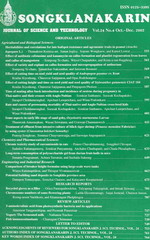ThaiScience
ThaiScience
SONGKLANAKARIN JOURNAL OF SCIENCE & TECHNOLOGY
Volume 41, No. 05, Month SEPTEMBER, Year 2019, Pages 1021 - 1028
Histological description of exobasidium vexans infection on tea leaves (camellia sinensis)
Norsyuhada Mohktar and Hideyuki Nagao
Abstract Download PDF
Exobasidium vexans Massee is a parasitic fungus that causes tea blister blight. Tea blister blight is characterized by swelling of infected spots on tea leaves. To date, there is limited information on the cellular alterations that occur during E. vexans infection. This study aimed to observe the histological changes on tea leaves infected by E. vexans. Diseased and healthy leaves were thin-sliced by a cryostat microtome and examined by light microscopy. Observations on the thin sections revealed the mode of hymenium development in E. vexans in which the basidia protruded between the epidermal cells. The infection caused hypertrophy as the size of the cells at the infected spots became double the size of the healthy cells. We also report the first description of venous infections of E. vexans. The proliferation of the fungus on the vein resulted in the formation of hymenium on both the lower and upper sides of the leaves and there was complete disruption of the vascular bundle in the leaf veins. Blister blight disease was found to be moderately severe at the tea plantation in this study. Morphological and molecular identification confirmed that the fungus isolated from the symptomatic leaves was E. vexans
Keywords
disease severity, leaf galls, cell differentiation, mesophyll, phloem, plant parasiteSONGKLANAKARIN JOURNAL OF SCIENCE & TECHNOLOGY
Published by : Prince of Songkla University
Contributions welcome at : http://rdo.psu.ac.th
